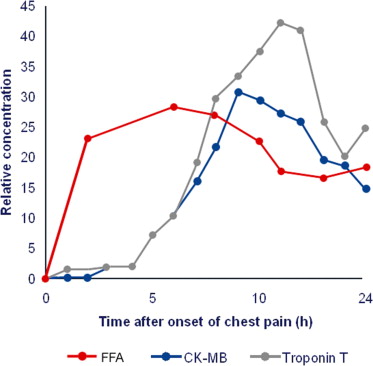Maintenance or restoration of normal myocardial metabolism during acute ischemia has seldom been a priority in its management. The focus for many years has been on overcoming impaired coronary blood supply. Depending on the severity, this may or may not restore abnormal myocardial metabolism. Yet, it is a functioning myocardium that will determine survival and prognosis.
Normal myocardial metabolism depends on a balanced supply of fatty acids, glucose, pyruvate, and lactate—the principal substrates. An excess of free fatty acids (FFAs) to local ischemic areas could uncouple oxidative metabolism with irreparable damage and lethal arrhythmias. The fear and pain, which usually occurs during impending infarction, is accompanied by a surge of adrenaline leading to lipolysis of stored tissue glycerides and a large and immediate efflux of FFAs throwing the balance of substrates awry. Studies conducted during the first hours after the onset of symptoms indicate that there is an excess of ventricular arrhythmias and mortality, both of which have been correlated with high concentrations of plasma FFA.
In this issue, Kleinfeld et al, using data from the Thrombolysis In Myocardial Infarction II trial of thrombolysis for ST elevation myocardial infarction, have shown that this is also true for unbound FFA (FFA u ). FFA u is a very small fraction of total FFA. It increases exponentially with increasing total albumin-bound FFA and is more sensitive to physiological changes. In 1,834 patients, the upper 2 quartiles of FFA u were associated with a significantly higher mortality rate at 1, 7, and 30 days after acute myocardial infarction. In this study, high FFA u was a risk factor independent of age, gender, race, body mass index, diastolic and systolic blood pressures at baseline, history of diabetes, previous myocardial infarction and hypertension, and use of β blockers within 24 hours of enrollment. This confirms earlier reports of the association of ventricular arrhythmias with high plasma concentrations of FFA.
Proof that it is the high concentrations of FFA that impair myocardial metabolism has previously been demonstrated in dogs with experimental myocardial ischemia, which were given heparin and protamine sulfate. Heparin induced plasma lipolysis leading to high concentrations of plasma FFA and ventricular arrhythmias. Both could be decreased by protamine sulfate. Also, infusions of lipid-free albumin to dogs with coronary artery occlusion resulted in rapid reduction of myocardial uptake of FFA and of ST elevation in contrast to the effects of infusion of normal albumin.
This renewed interest in fatty acids raises 2 important issues. One is that measurements of FFA are earlier biomarkers of prognosis than any of the cardiac enzymes (see Figure 1 ). I believe that FFA should always be measured in patients with impending infarction. Total FFA can now be measured through commercially available kits. The other is that measurement of FFA or FFA u has considerable therapeutic potential. The chief question is whether tissue lipolysis, which occurs during sympathetic stimulation, can be controlled sufficiently to modify plasma concentrations of FFA and FFA u . There is also the possibility that fatty acid transport across cell membranes might be inhibited. If lipolysis can be inhibited during an acute coronary syndrome, it is predictable that fewer ventricular arrhythmias will occur and early mortality will be reduced. In this regard, the lipase-inhibiting effect of nicotinic acid has been forgotten. More than 50 years ago, Carlson and Oro demonstrated that nicotinic acid led to a “metabolic type of sympathicolysis” with a rapid decrease in FFA, and we have shown that arrhythmias and ST elevation occurring during ischemia can be reduced by a nicotinic acid analog.





